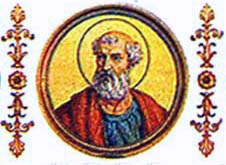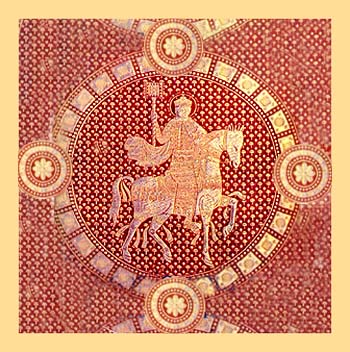 |
The Saint of the Day
Pope St. Pius I, July 11
Prof. Plinio Corrêa de Oliveira
Biographical selection:
St. Pius I (140-155) was born in the city of Aquilea, He succeeded St. Hyginus (136-140) in the Apostolic See. He was
a friend of St. Polycarp of Smyrna and St. Justin the Apologist, who fought against the Gnostic heresy that was contaminating the Church. St. Pius I demanded the highest respect for the consecrated species of Bread and Wine in the Eucharist. He made a special decree prescribing that if a negligent priest would let even a drop of the Precious Blood fall on the ground he would have to make 40 days of penance. If the Precious Blood would be spilled on the Altar and not onto the ground, the penance would be between 3-9 days, depending upon the quantity spilled.
One of the places where St. Peter and St. Paul used to work, the palace of St. Pudentiana, was transformed by Pope Pius I into a church. After governing the Catholic Church for 15 years, St. Pius I suffered martyrdom under Marcus Aurelius.
Comments of Prof. Plinio:
One can see that St. Pius I was a Pope who carried out his functions during the period of the Roman persecutions. Thus he counts among those first Popes who were associated with the admirable work of the internal organization of the Church. This is a very important point that historians and scholars habitually overlook.

St. Pius I |
During the persecutions, even when she was being stepped on and wounded, even when she was pouring out blood in all her parts, the Catholic Church continued to organize herself. After Constantine’s decree that gave liberty to the Church, she came out of the catacombs, and one could admire her full and perfect organization: she had a Hierarchy, an exact Church Law, all her structures had been made, her liturgy defined, and a wealth of doctrine established. This means that from the time that St. Peter and St. Paul arrived in Rome until the moment the Church left the catacombs, an enormous work of organization had been carried out.
The Catholic Church appeared as the first entity in History claiming a universal character. Until then, this idea was absurd. All the existent religions and other organizations were limited by borders of State. The Church claimed this universality naturally, wisely, and with good sense. She emerged from the catacombs already with her universal character and carried on naturally because everything was already prepared for that.
This means that even while she was suffering persecutions, she was not obsessed by them. At the same time, she was serenely constructing her magnificent structure. One might think that the development of the body of the Church would need to be made in peace and tranquility, that persecuted men could never do such a thing. But the opposite is true.
Throughout that period, those very men who were threatened, persecuted, at constant risk of being brought before the Roman tribunals and receiving their martyrdom, never ceased thinking, praying, and making the Church more perfect – here a point of doctrine was polished, there a part of the liturgy was improved, over there a new custom was being established. Considering this serenity and calm, one is reminded of the serenity and calm of the martyrs in the arena. That tranquility before death was present at the tragic moment when they were facing beasts and tortures. This was a consequence of a state of spirit fostered by the Catholic Church that kept them in a constant state of confidence and calm. This also explains why they were able to calmly and serenely construct, stone by stone, the extraordinary institution that they built.

A precious cloth representing Emperor Constantine, whose famous decree gave liberty to the Church. She emerged from the catacombs with an established structure and organization
|
The contemplative state also was born in the Church as another consequence of the persecutions. Many Catholics, fleeing the persecutions of the pagan Roman Empire, found refuge in the desert. There they began to dwell in isolation, living lives of prayer and sacrifice, which became the eremitic life of contemplation.
Here, then, one sees the admirable panorama of the life of the Church at that time: The great ever growing number of martyrs, the apostolate of the Church extending to all corners, her spirit of recollection giving rise to a flourishing contemplative state. It was an admirable growth and development.
Behind all those initiatives was the presence of the Holy Ghost. The Roman Catholic Church is more than a society of defined persons – the Pope, Bishops, Clergy, and faithful. This is the human element of the Church. But there is also that which is called the spirit of the Church. This spirit is the continuity in the Church of a determined mentality, a determined wisdom, a determined Faith, and a determined virtue, which exists not by a work of man, but by a supernatural factor: this is the action of the Holy Ghost. By means of this action, good Catholics everywhere in all centuries understood each other, knew each other, and supported each other. They had a single mentality, and when they died, others came and succeeded them with the same spirit.
Today the faithful who understand and love this same institution, virtue, and tradition have this spirit and represent this continuity. You have certainly seen a fire burning at night, when the flames are more easily seen. Once in a while, a spark shoots out from the fire, flies high above it, and then falls again into the bosom of the burning wood. Those good Catholics of whom I spoke are like those sparks in the fire. Amid the present crisis of the Church, those sparks shine with the light of the Church, with the light that the Church had before the Council, and they fly up and they will return their light and their very existence to her after her restoration. I hope we make up part of these Catholics. Our joy is to be a part of the Catholic Church. Anything good in us comes from our belonging to her, which is a Temple of the Holy Ghost.
There is a certain analogy between the faithful of the time of St. Pius I and today’s faithful. Today’s good Catholics do not suffer a bloody persecution. Instead they face a bloodless persecution and are maltreated in many ways. Our Lady helps them, and they continue on constructing their work stone by stone in that same spirit, until that moment Our Lady will choose for her glorification, and the Reign of Mary will be established. Then future Catholics will see that even amid the worse torments in History, which is the present day crisis, the Church continued to live, to progress, to give good fruit, and, moreover, she continued to be herself.
These are the considerations on the feast of St. Pius that I can offer you.


  | | Prof. Plinio Corrêa de Oliveira | |
The Saint of the Day features highlights from the lives of saints based on comments made by the late Prof. Plinio Corrêa de Oliveira. Following the example of St. John Bosco who used to make similar talks for the boys of his College, each evening it was Prof. Plinio’s custom to make a short commentary on the lives of the next day’s saint in a meeting for youth in order to encourage them in the practice of virtue and love for the Catholic Church. TIA thought that its readers could profit from these valuable commentaries.
The texts of both the biographical data and the comments come from personal notes taken by Atila S. Guimarães from 1964 to 1995. Given the fact that the source is a personal notebook, it is possible that at times the biographic notes transcribed here will not rigorously follow the original text read by Prof. Plinio. The commentaries have also been adapted and translated for TIA’s site.
|
Saint of the Day | Home | Books | CDs | Search | Contact Us | Donate

© 2002- Tradition in Action, Inc. All Rights Reserved
|
 |
|